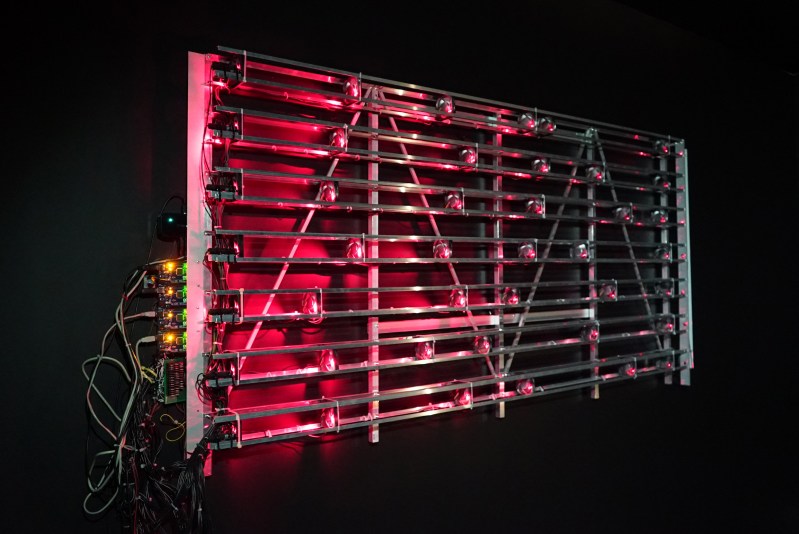[dmitry] writes in to let us know about a new project that combines lasers with fans and turns the resulting modulation of the light beams into an autonomous soundscape. The piece is called “divider” and is a large, wall-mounted set of rails upon which seven red lasers are mounted on one end with seven matching light sensors mounted on the other end. Interrupting the lasers’ paths are forty-two brushless fans. Four Arduino Megas control the unit.
 Laser beams shining into light sensors don’t do much of anything on their own, but when spinning fan blades interrupt each laser beam it modulates the solid beams and turns the readings of the sensors on the far end into a changing electrical signal which can be played as sound. Light being modulated by fan blades to create sound is the operating principle behind a Fan Synth, which we’ve discussed before as being a kind of siren (or you can go direct to that article’s fan synth demo video to hear what kind of sounds are possible from such a system.)
Laser beams shining into light sensors don’t do much of anything on their own, but when spinning fan blades interrupt each laser beam it modulates the solid beams and turns the readings of the sensors on the far end into a changing electrical signal which can be played as sound. Light being modulated by fan blades to create sound is the operating principle behind a Fan Synth, which we’ve discussed before as being a kind of siren (or you can go direct to that article’s fan synth demo video to hear what kind of sounds are possible from such a system.)
This project takes this entire concept of a fan synth further by not only increasing the number of lasers and fans, but by tying it all together into an autonomous system. The lasers are interrupted repeatedly and constantly, but never simultaneously. Listen to and watch it in action in the video below.
There isn’t a lot of in-depth technical information on the project page, but there are many really good photos. We especially love the way that the whole assembly is highly visual with the lasers turning on and off and interacting with different fans.
Any changing electrical signal can be played as sound, and if there’s one thing projects like self-playing musical hardware can teach us, it’s that if you have an electrical signal that looks strange or chaotic, hook a speaker up to it because it probably sounds pretty cool!
















oww, my ears. Every dog near this place is in a panic I bet.
I thought I was too old to hear those frequencies any longer. It’s cool, but needs to be shifted down a few dozen octaves
I’ve played with what was basically an interferometer, with its photodetector output connected to (among other things) an amplifier and speaker. The physicist running it could tell a lot about how it was behaving just based on how it sounded. I noticed that it was very sensitive to motion, and one could make all sorts of squeaks and squeals and tones by touching / tapping / moving things in the optical path.
Wouldn’t a better synth be adjustable fans in series, with a laser on one side and a light sensor on the other. So you can slide the fans left and right on the rails to adjust their spacing as well as some kind of PWM control to adjust their motor speed. That would be pretty cool.
Well, that was in all ways thoroughly unpleasant. What’s next from our comrades, a Crazy Ivan desktop toy?
Underwhelming. This is two art-tech projects I’ve seen in one day. Both terrible. Just because you have an idea, it doesn’t make it a good one. Your best idea will come from hundreds, not a pool of 5.